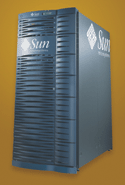Sun's Up On Grid Computing
The program is expected to be based in part on a current push to get Sun's European solution providers to work with grid computing, said Peter Jeffcock, group marketing manager for Sun's Grid Computing Group.
In the technical-computing space, customers that employ computing grids,groups of servers whose processing power is shared for a specific task,can measurably reduce their computing costs and improve server utilization, Jeffcock said.
Solution providers should consider adding grid computing to their line cards because it is a vastly underserved market, he said. There are about 6,500 computing grids in use worldwide,about half of which are in the United States,and this number is growing by about 70 a week, he said.

\
Servers such as the SunFire 15K present an opportunity in the grid computing arena.
There is more opportunity than most people realize, said Ron Lee, manager at Grid Queuing Systems, an Issaquah, Wash.-based Sun solution provider that specializes in grid computing.
Lee said Jeffcock's estimate of 70 new grids being employed worldwide each week is low. "I think that's a very conservative number," Lee said. "Grid computing is a really hot topic now."
Grid Queuing is a three-person company founded to develop grid solutions for customers, Lee said. The company works with a variety of grid-computing software packages, including Sun Grid Engine, NASA's Portable Batch System and the Load Sharing Facility from Platform Computing, primarily on Unix platforms.
While grid computing started as a way for companies to recover the "white space," or unused idle of their computers' processors, it is currently being spread across continents, Lee said.
"Our emphasis is to move to architectures where grid computing is currently not supported, including Windows machines or even PDAs," he said. "At the Supercomputing Conference last month, I saw all these 'geeks' walking around with wireless PDAs, and thought, 'I can use them to start grid jobs or, with larger PDAs, even run the grid jobs.' If you can put a Windows operating system on it, we can do something with it."
Grid Queuing is supporting Sun Grid Engine software because it allows porting to an object-oriented language, Lee said. As a result, an application needs to be written only once, after which it can be run anywhere. "This will allow us to bring PCs in and get even more resources for developing grids," he said.
Oliver Poppenberg, vice president of sales at Perfect Order, a Pittsburgh-based Sun solution provider, said his company is interested in grid computing but has not yet entered the arena.
One potential market for grid computing is competing against Wintel clusters, Poppenberg said. "Grid computing is big in universities. A lot of people there are writing their own code. The applications are already there. And they're moving into the commercial market," he said.
Sun wants to rely more on its channel partners now than in the past because most grids are heterogeneous in nature, Jeffcock said. "They typically are started for a single project. But then other projects are started. Then the different projects get together. So they eventually become heterogeneous," he said.
Sun currently offers its Sun ONE Grid Engine software as a free download and also has an Enterprise Edition available for purchase. Jeffcock said the difference between the two is felt when multiple projects start to steal resources from each other, in which case the Enterprise Edition allows companies to set clear policies.
The company will unveil a formal channel program for its U.S.-based solution providers in the first half of 2003, Jeffcock said. The program will be linked to Sun's N1 network architecture at the same time that the latter comes to market, he said.